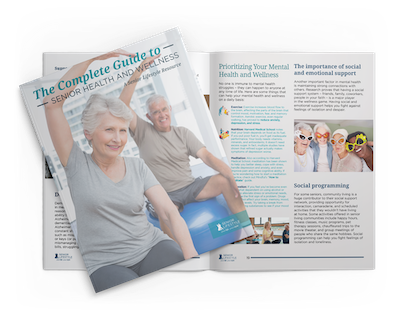Food allergies are a growing concern in the senior population, affecting many older people. Studies say that 5% to 10% of older people have some sort of allergy, including food allergies, according to the World Allergy Organization. Food allergies can cause a range of symptoms from mild itching and hives to life-threatening anaphylaxis.
It’s important to know that you can develop food allergies later in life. Find out more about common food allergies in seniors, how to recognize the types of food allergy reactions and what can be done to manage them.
Why Food Allergies Are Getting Worse With Age
A simple explanation for the growth of late-onset food allergies is the fact that people are living longer. As people get older, underlying physiological changes occur, and the risk of chronic diseases rises.
Iron deficiency, which is common in older people, can also lead to developing food allergies later in life, according to the National Institutes for Health. Drug treatments also can cause increased food allergies. The NIH says that since food allergies are increasing in all people, there will be an increase in seniors, too.
The NIH also says that since a number of factors may cause or contribute to allergies, many conditions can be hard to diagnose as allergies. Among the challenges are non-typical symptoms, existing conditions and medications, and lack of awareness of the risks.
Some of the symptoms of allergies in seniors may include confusion, dizziness and fatigue, which may be mistaken for other conditions, leading to delayed diagnosis and treatment. For those reasons, if you’re a senior suffering from some other condition or disease, you should be tested for allergies.
Common Food Allergies in Seniors
Dairy
You may develop dairy allergies, from mild to severe, as you age. The allergy is due to being unable to fully digest the milk sugar lactose. Symptoms can include bloating, diarrhea and gas. In rare cases, milk allergy can cause anaphylaxis, which is a life-threatening condition.
Symptoms of lactose intolerance usually begin 30 minutes to two hours after eating or drinking foods containing milk.
Fish
Some fish, including halibut, salmon and tuna, are often linked to late-onset food allergies. You can be allergic to one type of fish but not to others.
Allergic reactions may include mouth and throat irritation and swelling, difficulty breathing, and possibly nausea and vomiting.
Fruits and Vegetables
This is a common allergy in adults, known as allergy syndrome or pollen-food allergy syndrome. The body’s immune system can mistake certain proteins in fruits and vegetables for the proteins found in pollen.
Allergic reactions, usually after eating raw fruits or vegetables, include itching lips, mouth and throat, followed by tingling, redness, swelling and blisters in the most extreme cases.
Peanuts
Can you develop a peanut allergy later in life? Certainly! Such allergies are on the rise in the general population, and peanut allergies are considered one of the most hazardous since it often can lead to anaphylactic shock. Among the reactions include:
- Breathing difficulties
- Collapse or loss of consciousness
- Confusion and anxiety
- Fast heartbeat
- Lightheadedness
This is a very serious allergy that must be treated quickly.
Shellfish
Crustacean and mollusk allergies are common. An allergic reaction to one type of shellfish can carry over to others. If you are allergic to one type of shellfish, you’ll often be advised to avoid all types.
The shellfish to avoid include:
- Clams
- Crabs
- Lobsters
- Mussels
- Oysters
- Scallops
- Shrimp
Soy
Most allergic reactions to soy tend to be mild, but you may experience severe symptoms. These include cough, itching and stomach problems.
Soybeans are a member of the same family as peanuts. While those with peanut allergies don’t usually have soy allergies, most people who are allergic to soy are also allergic to peanuts.
Tree Nuts
These nuts include almonds, hazelnuts, pecans and pistachios. Allergic reactions to tree nuts can be mild to severe, including anaphylactic shock.
If you’re allergic to one type of nut, you’ll usually be advised to avoid all types to be safe.
Wheat
Wheat allergies are a sensitivity to the protein gluten, which is also found in barley, oats and rye. Also known as celiac disease or gluten-sensitive enteropathy, the condition causes inflammation in the gastrointestinal tract, which also interferes with the absorption of nutrients.
Symptoms of wheat or gluten allergies can include bloating, diarrhea, nausea, vomiting and weight loss.
Managing Senior Food Allergies
Seniors can manage their food allergies by avoiding the allergens, taking medications for symptom relief, and, in extreme cases, using epinephrine auto-injectors. Counseling and education for patients and caregivers are also essential for the proper management of food allergies.
At Senior Lifestyle, you can be sure we watch out for the nutrition needs of our residents, including their food allergies. We also look out for your health at Senior Lifestyle communities, with medical care available round the clock.
Seniors and their families can be assured that safe, delicious meals are served every day. Senior Lifestyle focuses on combining the joys of dining with the nutrition that experts say residents need to live a healthy life.
>> Read “What to Expect When Dining at a Senior Community”
Each community offers its own unique culinary experience, but you can expect the following at a Senior Lifestyle community:
- Decadent desserts
- Distinct and dynamic menu choices
- Family and guest dining for deeper connections
- Menus that suit personalized and customized resident diets
- Nutritious meals to promote wellness
- Restaurant-style dining
- Seasonal cuisine and holiday fare for special events
Our team members invites residents to share with us how we can cater to their medical, nutritional, dietary and taste preferences. Our communities also ask for feedback on the dining experience and to provide recipes to be included in each community’s weekly menus.

Download The Complete Guide to Senior Health and Wellness
The key to living your “best life” as you age? Prioritizing your health. Check out our eBook, “The Complete Guide to Senior Health and Wellness,” to learn about the most important aspects of senior health and wellness.
Download the GuideLive a Happy and Healthy Life at Senior Lifestyle
Senior Lifestyle gives you plenty of choices to make your new life a safe, secure one. With several levels of care, classes and activities, food options, and other choices to pick from, you can feel at home as your day-to-day needs are looked after.
Find out more about Senior Lifestyle or schedule a visit today.

